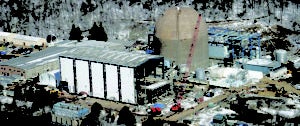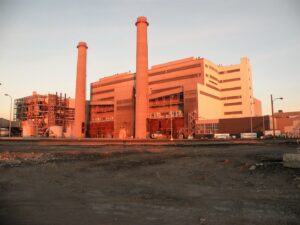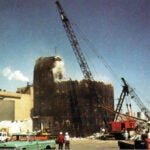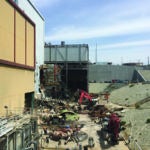
Successful decommissioning of a retired power plant includes a safe shutdown of operations, and sometimes preparing the site for future use. Hazardous materials must be removed, equipment and structures need to be dismantled, and specific sites may require environmental remediation. It’s a process that varies depending on the type of power station, with different protocols for fossil fuel-burning units, nuclear power plants—a closure process that is heavily regulated—or a renewable energy site.
Keith Kotimko is the U.S. Decommissioning and Demolition Leader for WSP, a full-service solution provider that offers several services to the energy sector, including comprehensive facility decommissioning and demolition. Kotimko provided POWER with insight into the process of permanently shutting down a power generation facility. He emphasized that decommissioning is a separate activity from demolition. “Decommissioning is the specific activity that serves as the necessary precursor to demolition,” he said. “It encompasses all steps required to prepare the plant for subsequent abatement and physical tearing down.”

Kotimko, who said he has been directly involved in planning and executing decommissioning of seven coal-fired power plants over the past 11 years, detailed several steps in the shutdown process. He said it includes “fundamental actions such as cessation of generation, thorough emptying and cleaning of major systems [like ash and coal handling], draining all oils and fuels, purging gas systems, and complete removal of all stored hazardous and non-hazardous waste. It culminates in de-energizing the assets and separating them from transmission and distribution systems.” Kotimko said utilities often manage these preparatory activities internally as a “last outage event” before vacating the site.
Kotimko said that while his decommissioning experience is with coal-fired facilities, his demolition experience is broader, encompassing 24 plants of various types, including coal, oil, natural gas, hydro, and nuclear facilities.
POWER: What are some of the main reasons power plants are decommissioned (economic, end of life, safety concerns, regulatory policies, etc.)?
Kotimko: For the coal plants I have worked on, the primary driver for decommissioning has been economic factors. Specifically, these facilities were retired because of the availability of cheaper alternative generation options.
POWER: Please provide information about the steps necessary to decommission a power generation
facility.
Kotimko: Successful decommissioning hinges on detailed preparation that goes beyond standard operating procedures. We focus on three critical topics upfront, which, if handled correctly, can reduce added contingency costs in contractor bids, prevent environmental releases and minimize expensive change orders later:
Decommissioning is Not a Standard Plant Outage: Although decommissioning shares activities with plant outages (like cleaning and draining), the required level of effort is fundamentally different. In decommissioning, it is unacceptable to leave hardened ash or unclean ductwork, even if that might be permissible during a temporary outage. When an owner performs only an “outage level” of cleaning, the demolition contractor will inevitably find large, residual quantities of materials, triggering change orders and often leading to environmental releases onto the ground or into water systems.
To prevent this, utilities must define and achieve a much higher standard of removal and cleaning during the “last outage”. This requires a detailed scope of work (SOW) that:
- Lists all systems requiring cleaning.
- Specifies the means to access equipment (e.g., number of access hatches).
- Defines the required level of cleanliness (e.g., 1/16-inch maximum for coal dust).
- Identifies specific waste streams and their exact disposition (e.g., ash solids to the on-site landfill versus sump water transported offsite).
Using experienced, knowledgeable plant personnel for this intensive cleaning often saves both time and money compared to pushing the full effort to the demolition contractor, who will likely subcontract it and apply a mark-up.
Plant Shutdown Alterations to Aid Demolition Work: While the ideal goal is to achieve a “cold, dark and dry” state, continuous operations are sometimes necessary, such as running sumps to prevent basement flooding or maintaining FAA (Federal Aviation Administration) lighting on structures. Owners must proactively evaluate what utilities they are willing to provide for the contractor’s use, including power, water and treatment/discharge systems.
Owner-provided utilities are generally safer (as plant personnel know the system) and help reduce overall project cost. Providing power to the site, for instance, can prevent the contractor from needing to use large generators that may require a new air permit—a regulatory burden most utilities want to avoid.
All requirements for utility use must be specified in the demolition contractor’s SOW. This should include explicit details, such as the setup location and capacity of owner-provided power (e.g., “800 amp service setup at X location”). It also should include specific requirements for treating and discharging generated water streams (e.g., dual 5-micron filtration for abatement shower water).
POWER: What are the major challenges for companies involved in the decommissioning of power plants?
Kotimko: The major operational challenge centers around the owner’s expertise in generating power, not in shutting down, decommissioning, abating and demolishing an entire plant. For us, the definition of success in these projects must include safety being paramount alongside the prevention of change orders.
Change orders are not an expected part of the project; they are typically the result of insufficient planning and scoping. The four most common categories of change orders stem from:
- Poorly Defined Cleaning Scope: This is the most immediate change order, usually resulting from generalized requirements for material removal that fail to achieve the necessary level of cleanliness needed for demolition.
- Inadequate Asbestos Surveys: This is frequently the second and most substantial category of change order. Surveys must be intrusive enough to find hidden materials that will undoubtedly be discovered during demolition. If sampling is limited, all suspect asbestos-containing materials must be quantified and addressed with a clear costing strategy in the Request for Proposal. Investing adequately in a thorough $150,000 Regulated Material Survey upfront is vastly superior to incurring hundreds of thousands, or even millions, in unexpected abatement change orders later.
- Insufficiently Detailed Site/Owner Requirements: These relate to differing expectations regarding operational standards, such as owner-specific SOPs, requirements for dust control and monitoring, or the acceptance process for required submittals.
- Poorly Defined Below-Grade Removal Work: Since contractors assess above-grade demolition visually, below-grade work must be explicitly defined using drawings that specify the horizontal extent and vertical depth of all utilities, foundations and buried features to be removed. This often-overlooked step requires combing through existing documents and potentially performing utility locating services.
Ultimately, all these challenges can be mitigated through vigorous upfront diligence. Investing the necessary time and money, utilizing a combined team of the owner and a highly experienced owner’s engineer, is the best opportunity to minimize overall project cost, reduce contingency pricing and eliminate change orders.
—Darrell Proctor is a senior editor for POWER.










